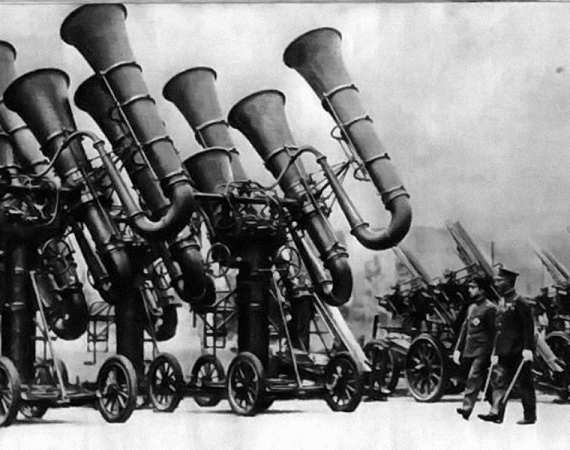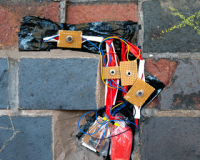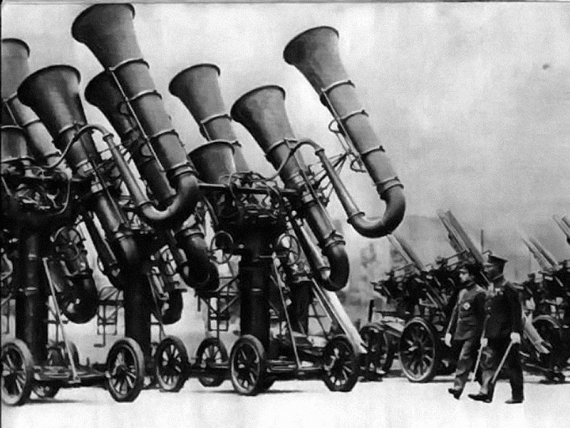Posted on Thu 26 May 2016
3 research projects for Geiger-Müller Sound System

Posted by
Project

Studio Residencies 2012: Geiger-Muller Sound System
Supported by a Studio Residency writer, performer and composer Timothy X Atack and musician, sound artist and instrument designer MrUnderwood developed a finite kinetic choir.
After a week of residency at Pervasive Media Studio, and much scribbling in notepads, and talk of Japanese War Tubas, and the culture of remixing, and the price of transducers (indeed, all the things you’d imagine two pasty nerds in sarcastic t-shirts to be talking about) Sam Underwood and I have boiled our collective brains down to 3 projects. The idea is that we’ll focus on these for the next few weeks, scoping out their feasibility, discussing their demands content-wise and technically, before settling on one project to prototype and test from November onwards.
It’s been an exciting conversation, much of it conducted in transit, trudging around the city and dreaming up impossible plans. But through constant listing, reiteration and a small amount of negotiation, we’ve found aims and ideas we’re both interested in pursuing. These seem to be centred upon issues of scale, myth, danger, and – in the last couple of days – a growing sense that we’d like to work on something politically engaged.
1. Unit Of Resistance
This is a speaker system in a large(ish) public place, rigged to activate only when two people connect to the poles of its interface and hold hands. It plays a message about where and who we are; the state we’re in, our fears for the future. If more people join hands, an inversion of the electrical resistance they create makes the playback of the message louder. So for instance, 50 people would make the sound audible across the entire site. 200 people would make it audible from a distance.
In addition, a certain critical mass of people holding hands adds further elements to the soundtrack: music, perhaps variations in the message, maybe other voices. More bodies give the broadcast sound a different emotional tilt. The implicit risk is that anyone taking part, at any point, can cut the sound dead – simply by breaking contact. You can opt out at any time.
Key questions:
Nature of the message. We have a feeling that it needs to be nakedly political, to represent ‘resistance’ in all its meanings. How to make this content accessible… emotionally, intellectually, dramatically? How to make it worth – for instance – standing in the rain for half an hour?
Electrical resistance. What sort of parameters will we be working to? What will cold weather, moisture, different body mass do to the technology?
Aesthetic. What will the interface itself look and feel like, will it represent the amplified content in any way?
2. Harp For The End Of The World
To make an instrument out of a building of considerable height; modelled on an idea around Cabot Tower but adaptable to any structure tall enough, eg. the cranes on the dockside, Westmoreland House.
Oversized ‘harp strings’ would be rigged from ground level to tuning pegs at the top of the structure; they would be playable, and produce acoustic tones. They might be struck (perhaps with a mallet) or plucked.
We’d investigate infrasonics – looking at the feasibility of our harp strings producing sub-audible bass frequencies. We’d construct a modern mythological text around our unfeasible instrument, describing how a certain sequence of notes or chords would destroy the harp’s immediate environment.
Key questions:
Structural integrity. Is this at all realistic? We’d ideally like the harp to be applicable to more than one structure or space. Can we create a safe but flexible design?
Why? This project has a primal resonance for us. It’s a basic kind of instrument, but the idea is linked to cave paintings, shamanism (the theory of achieving hallucinatory visions through exposure to infrasonic frequencies) and myths born of human music-making. How will this be reflected in our instructions – or other texts – for the audience?
3. Finite Radioactive Choir
This is a series of self-contained units which produce a very low volume sound for a period of 100 years. They are ‘released’ into the wild and tracked voluntarily by means of an online wiki, perhaps by their owners… or anyone who chances to come across them. We attach no conditions to the movement of these units – they can be bought, sold, hidden, displayed, whatever, it’s beyond our control. But their sound can’t be stopped.
The units would have to run on a constant long-life power source that eventually faded (perhaps thermal or atomic.) They would have one ‘playable’ aspect: a different recording would emit from them depending on which side the unit was resting on.
In terms of the content of the emitted sound, it would have to be something that acknowledged the units’ provenance and longevity. It could be music, words, or ambient sound. It’s highly likely that it would only be audible if you held the unit to your ear, or directed a microphone towards it… like a ghostly whisper from the past. But should you meet up with other units and their owners, listening to them in unison would make a kind of sense – even if it was a dissonant one.
Key questions:
Legality. Obviously the use of constant power sources – and beyond that, instruments that never switch off – needs to be thought through with immense care and attention to detail. We’d also need to look at the implications on the basic level of repercussions for our environment and to consider the units’ eventual disposal. How would we label the devices? Do we need take much more care in how we disperse them?
Indestructibility. This is plainly impossible to guarantee, but how do we get as close as we can to a 100-year longevity? Do we use transducers instead of loudspeakers to make each unit a solid object? How large will we have to make the instruments, and what will that mean for their mobility?
